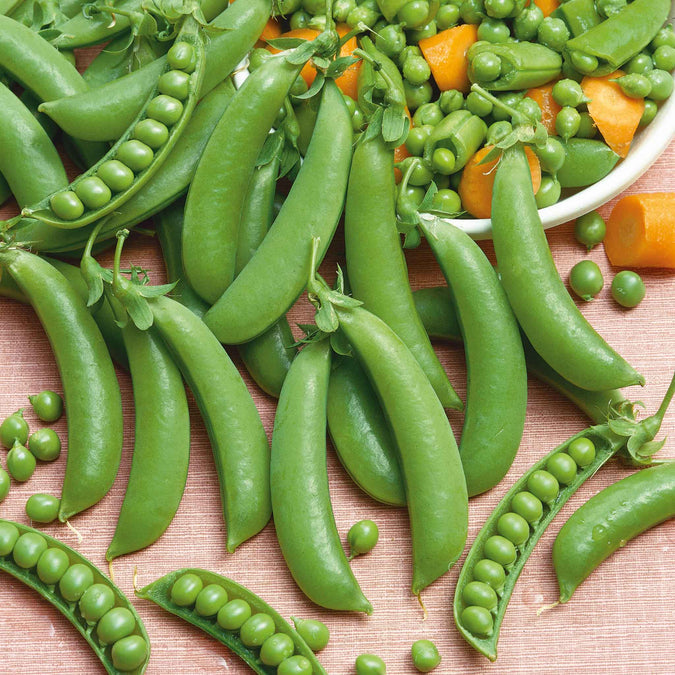
Dharaseeds
Pea Seeds - Sugar Snap (Snap Pea)
Estimated Free Delivery between April 16 and April 19.
Secured Payment Methods
Your transaction is protected with advanced security measures to keep your information confidential
Sugar Snap peas are the original snap pea variety, famous for their sweet, crunchy pods and versatility. These robust, vining plants produce an abundance of edible pods filled with tender peas, perfect for snacking, stir-fries, or salads. Sugar Snap peas thrive in cool weather, and their climbing habit makes them ideal for small garden spaces with vertical support. Whether eaten raw or cooked, their delightful sweetness and crisp texture make them a favorite among gardeners and chefs alike.
Key Benefits
- Exceptional Flavor: Sweet, crunchy pods that can be eaten whole, offering the best of both snow peas and garden peas.
- High Yield: Produces an abundance of pods over a long harvest period.
- Versatile in the Kitchen: Perfect for fresh eating, steaming, stir-frying, and more.
- Vigorous Vines: Climbs easily with support, saving space and maximizing productivity.
- Cold Tolerance: Thrives in cooler weather, making it ideal for spring and fall planting.
Variety Features
- Plant Characteristics: Vigorous, climbing vines reaching 5–6 feet in height.
- Flavor Profile: Sweet, juicy pods with a crisp texture.
- Growth Habit: Vining plants require trellising for optimal growth and easier harvesting.
- Size: Pods measure 3–4 inches long, packed with plump, tender peas.
Planting Instructions
Planting Season
- Plant in early spring as soon as the soil is workable.
- For a fall harvest, sow seeds in late summer or early fall in regions with mild winters.
Planting Details
- Seed Depth: Plant seeds 1–1.5 inches deep.
- Spacing: Space seeds 2–3 inches apart in rows 18–24 inches apart.
- Soil Requirements: Prefers well-drained, fertile soil with a pH of 6.0–7.5.
- Sunlight: Requires full sun to partial shade.
Care Instructions
Watering
- Keep soil evenly moist but avoid overwatering, which can lead to root rot.
- Provide about 1 inch of water per week, especially during flowering and pod development.
Fertilization
- Peas fix their own nitrogen; use a low-nitrogen fertilizer if necessary (e.g., 5-10-10).
Weeding and Mulching
- Weed regularly to reduce competition, taking care not to disturb shallow roots.
- Apply mulch to retain soil moisture and suppress weeds.
Trellising
- Use a trellis, fence, or netting to support the vines, improving air circulation and simplifying harvesting.
Pest and Disease Control
- Pests: Protect against aphids, pea weevils, and cutworms with insecticidal soap or floating row covers.
- Diseases: Rotate crops annually to prevent root rot and fungal infections. Ensure good air circulation to reduce powdery mildew risk.
Harvesting
Maturity
- Sugar Snap peas are ready for harvest in 60–70 days.
- Harvest pods when they are plump, bright green, and about 3–4 inches long.
Method
- Pinch or cut pods from the vine to prevent damage to the plant.
- Frequent picking encourages continued production throughout the season.
Storage
- Short-Term: Store fresh pods in the refrigerator in a perforated bag for up to a week.
- Long-Term: Blanch and freeze pods or peas for extended storage without losing flavor or texture.
Culinary Uses
- Snacking: Enjoy raw pods for a sweet and crunchy treat.
- Stir-Fries: Add snap peas to stir-fries for vibrant color and texture.
- Steamed or Sautéed: Cook lightly to preserve their sweetness and crunch.
- Salads: Slice raw pods for a crisp addition to salads.
Conclusion
Sugar Snap peas are a classic, easy-to-grow variety that offers sweet, crisp pods perfect for fresh eating and cooking. With their high yield, vigorous growth, and delightful flavor, they are a must-have for any garden. Whether climbing a trellis in a small space or sprawling across a larger plot, Sugar Snap peas deliver a rewarding harvest of nutritious and versatile produce.








